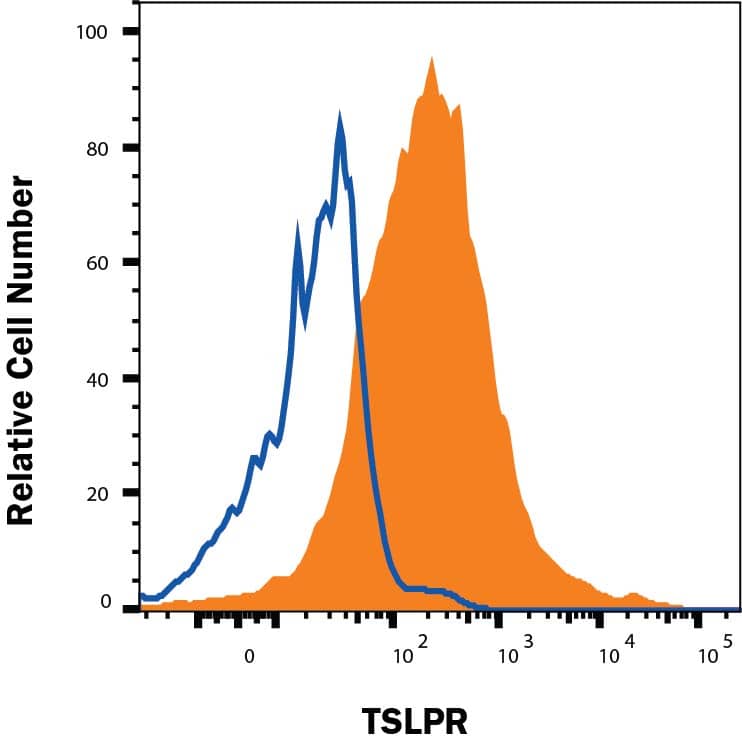Human TSLPR Antibody
R&D Systems, part of Bio-Techne | Catalog # MAB9811


Conjugate
Catalog #
Key Product Details
Species Reactivity
Human
Applications
Flow Cytometry, Western Blot
Label
Unconjugated
Antibody Source
Monoclonal Mouse IgG2B Clone # 179134
Product Specifications
Immunogen
Mouse myeloma cell line NS0-derived recombinant human TSLP R
Gly25-Lys231
Accession # Q9HC73
Gly25-Lys231
Accession # Q9HC73
Specificity
Detects human TSLP R in direct ELISAs.
Clonality
Monoclonal
Host
Mouse
Isotype
IgG2B
Scientific Data Images for Human TSLPR Antibody
Detection of Human TSLP R by Western Blot.
Western blot shows lysates of NS0 mouse myeloma cell line mock transfected or transfected with human TSLP R. PVDF membrane was probed with 0.5 µg/mL of Mouse Anti-Human TSLP R Monoclonal Antibody (Catalog # MAB9811) followed by HRP-conjugated Anti-Mouse IgG Secondary Antibody (HAF018). Specific bands were detected for TSLP R at approximately 45-60 kDa (as indicated). This experiment was conducted under reducing conditions and using Immunoblot Buffer Group 1.Detection of TSLPR in NS0 cells transfected with hTSLPR vs Irrelevant NS0 transfectant cells by Flow Cytometry.
NS0 cells transfected with hTSLPR (filled histogram) vs Irrelevant NS0 transfectant cells (open histogram) were stained with Mouse Anti-Human TSLPR Monoclonal Antibody (Catalog # MAB9811) followed by Phycoerythrin-conjugated Anti-Mouse IgG Secondary Antibody (Catalog # F0102B). View our protocol for Staining Membrane-associated Proteins.Applications for Human TSLPR Antibody
Application
Recommended Usage
Flow Cytometry
0.25 µg/106 cells
Sample: NS0 cells transfected with hTSLPR vs Irrelevant NS0 transfectant cells
Sample: NS0 cells transfected with hTSLPR vs Irrelevant NS0 transfectant cells
Western Blot
0.5 µg/mL
Sample: NS0 mouse myeloma cell line transfected with human TSLP R
Sample: NS0 mouse myeloma cell line transfected with human TSLP R
Formulation, Preparation, and Storage
Purification
Protein A or G purified from hybridoma culture supernatant
Reconstitution
Reconstitute at 0.5 mg/mL in sterile PBS. For liquid material, refer to CoA for concentration.
Formulation
Lyophilized from a 0.2 μm filtered solution in PBS with Trehalose. *Small pack size (SP) is supplied either lyophilized or as a 0.2 µm filtered solution in PBS.
Shipping
Lyophilized product is shipped at ambient temperature. Liquid small pack size (-SP) is shipped with polar packs. Upon receipt, store immediately at the temperature recommended below.
Stability & Storage
Use a manual defrost freezer and avoid repeated freeze-thaw cycles.
- 12 months from date of receipt, -20 to -70 °C as supplied.
- 1 month, 2 to 8 °C under sterile conditions after reconstitution.
- 6 months, -20 to -70 °C under sterile conditions after reconstitution.
Background: TSLPR
References
- Fujio, K. et al. (2000) Blood 95:2204.
- Hiroyama, T. et al. (2000) Biochem. Biophys. Res. Commun. 272:224.
- Park, L.S. et al. (2000) J. Exp. Med. 192:659.
- Tonozuka, Y. et al. (2001) Cytogenet. Cell Genet. 93:23.
- Reche, P.A. et al. (2001) J. Immunol. 167:336.
- Pandey, A. et al. (2000) Nat. Immunol. 1:59.
Long Name
Thymic Stromal Lymphopoietin Receptor
Alternate Names
CRL2, CRLF2, CRLM-2, PCOR1, TSLP R
Gene Symbol
CRLF2
UniProt
Additional TSLPR Products
Product Documents for Human TSLPR Antibody
Product Specific Notices for Human TSLPR Antibody
For research use only
